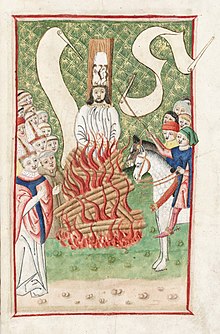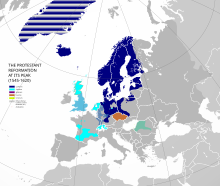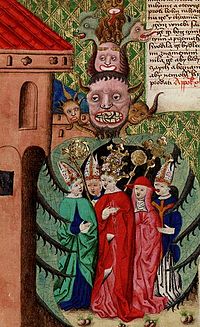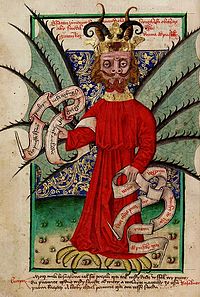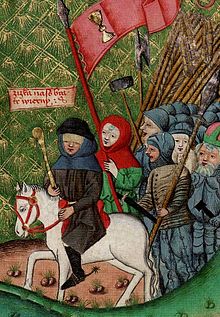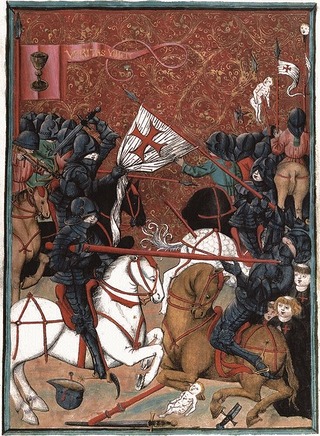
The Hussites were a Czech proto-Protestant Christian movement that followed the teachings of reformer Jan Hus, who became the best known representative of the Bohemian Reformation.

Jan Hus, sometimes anglicized as John Hus or John Huss, and referred to in historical texts as Iohannes Hus or Johannes Huss, was a Czech theologian and philosopher who became a Church reformer and the inspiration of Hussitism, a key predecessor to Protestantism, and a seminal figure in the Bohemian Reformation. Hus is considered by some to be the first Church reformer, even though some designate the theorist John Wycliffe. His teachings had a strong influence, most immediately in the approval of a reformed Bohemian religious denomination and, over a century later, on Martin Luther.

The Hussite Wars, also called the Bohemian Wars or the Hussite Revolution, were a series of civil wars fought between the Hussites and the combined Catholic forces of Holy Roman Emperor Sigismund, the Papacy, and European monarchs loyal to the Catholic Church, as well as various Hussite factions. At a late stage of the conflict, the Utraquists changed sides in 1432 to fight alongside Roman Catholics and opposed the Taborites and other Hussite spin-offs. These wars lasted from 1419 to approximately 1434.
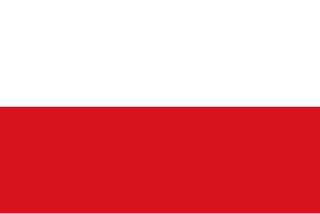
Although the Kingdom of Bohemia, both of the Lusatias, the Margraviate of Moravia, and Silesia were all under Habsburg rule, they followed different paths of development. Moravians and Silesians had accepted the hereditary right of the Austrian Habsburgs to rule and thus escaped the intense struggle between native estates and the Habsburg monarchy that was to characterize Bohemian history. In contrast, the Bohemian Kingdom had entrenched estates that were ready to defend what they considered their rights and liberties. The Habsburgs pursued a policy of centralization and conflict arose, which was further complicated by ethnic and religious issues.

Petr Chelčický was a Czech Christian spiritual leader and author in the 15th century Bohemia, now the Czech Republic. He was one of the most influential thinkers of the Bohemian Reformation. Petr Chelčický inspired the Unitas Fratrum, who opposed transubstantiation and monasticism, insisting on pacifism and the primacy of scripture. There are multiple parallels with the teachings of the Anabaptists and Petr Chelčický. Czech Baptists have also expressed continuity with the Bohemian reformation by identifying with Petr Chelčický.

The Moravian Church, or the Moravian Brethren, formally the Unitas Fratrum, is one of the oldest Protestant denominations in Christianity, dating back to the Bohemian Reformation of the 15th century and the Unity of the Brethren founded in the Kingdom of Bohemia, sixty years before Luther's Reformation.

The Kingdom of Bohemia, sometimes referenced in English literature as the Czech Kingdom, was a medieval and early modern monarchy in Central Europe. It was the predecessor of the modern Czech Republic.
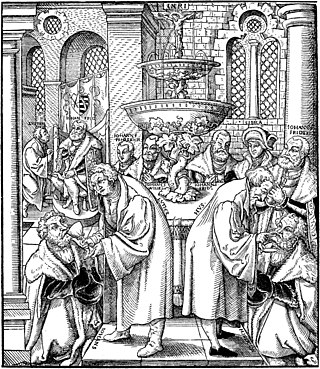
Utraquism or Calixtinism was a belief amongst Hussites, a reformist Christian movement, that communion under both kinds should be administered to the laity during the celebration of the Eucharist. It was a principal dogma of the Hussites and one of the Four Articles of Prague. After the Hussite movement split into various factions early in the Hussite Wars, Hussites that emphasized the laity's right to communion under both kinds became known as Moderate Hussites, Utraquist Hussites, or simply Utraquists. The Utraquists were the largest Hussite faction.

The Evangelical Church of Czech Brethren (ECCB) (Czech: Českobratrská církev evangelická; ČCE) is the largest Czech Protestant church and the second-largest church in the Czech Republic after the Catholic Church. It was formed in 1918 in Czechoslovakia through the unification of the Protestant churches of the Lutheran and Calvinist confessions.

The Czechoslovak Hussite Church is a Christian church that separated from the Catholic Church after World War I in former Czechoslovakia.

Jan Blahoslav was a Czech humanistic writer, poet, translator, etymologist, hymnographer, grammarian, music theorist and composer. He was a Unity of the Brethren bishop, and translated the New Testament into Czech in 1564. This was incorporated into the Bible of Kralice.
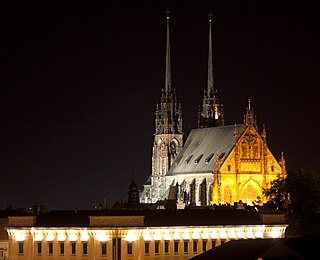
The Catholic Church in the Czech Republic is part of the worldwide Catholic Church, under the spiritual leadership of the Pope, curia in Rome, and the Conference of Czech Bishops.
Jacob of Mies was a Czech reformer from the Kingdom of Bohemia and colleague of Jan Hus.
This article covers the period from the origin of the Moravian Church, as well as the related Hussite Church and Unity of the Brethren, in the early fourteenth century to the beginning of mission work in 1732. Further expanding the article, attention will also be paid to the early Moravian settlement at Bethlehem, Pennsylvania, following their first arrival in Nazareth, Pennsylvania in 1740.
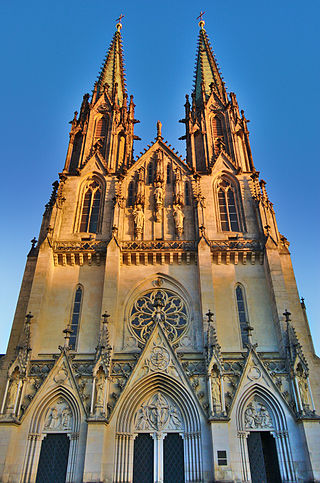
In the Czech Republic, 47.8% of population is irreligious, while 21.3% of the population are believers. The high percentage of irreligious people might be attributable to 40 years spent under Marxist-Leninist rule, during which atheism was institutionalised. The religious identity of the country has changed drastically since the first half of the 20th century, when more than 90% of Czechs were Christians. As of 2021, 11.7% of the population identified with Christianity whilst 10.8% identified with other religious identities or beliefs. According to sociologist Jan Spousta, not all the irreligious people are atheists; indeed, since the late 20th century there has been an increasing distancing from both Christian dogmatism and atheism, and at the same time ideas and non-institutional models similar to those of Eastern religions have become widespread through movements started by various gurus, and hermetic and mystical paths.

Music of the Czech Republic comprises the musical traditions of that state or the historical entities of which it is compound, i.e. the Czech lands. Czech music also constitutes a substantial part of the music culture of its direct predecessor, Czechoslovakia.
Religious peace of Kutná Hora was concluded in March 1485 by the Czech lands Diet in Kutná Hora between Utraquist Hussites and Roman Catholics. The agreement between representatives of both sides, reached after meeting from 13 March to 20 March, declared the agreement from the Basel Council the basic law of the land. The Utraquist and the Catholic faiths were declared equal in front of the law, and the religious peace (Landfried) was declared for the following 31 years. This agreement finished a long series of religious conflicts in the Czech lands and constituted a definitive end to the Hussite Wars. The Diet in 1512 confirmed the agreement and extended it in perpetuity. Religious peace and tolerance helped for development of the land, but it contributed to the future conflicts of interests between middle-class and nobility.
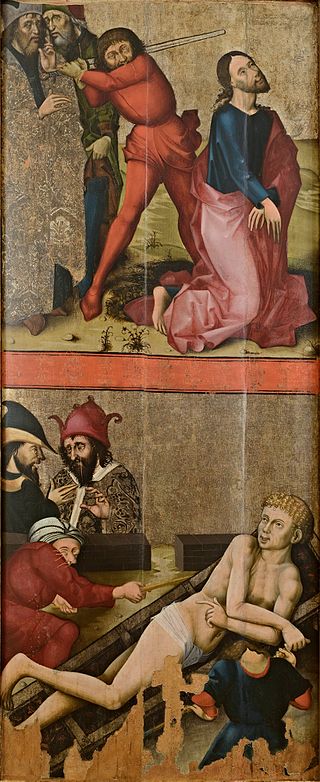
Altar Wings of Roudníky are two surviving wings of late Gothic retable, which probably originated in one of Prague's contemporary workshops for village (Utraquist) parish church. The altar wings exhibited at the Hussite Museum in Tábor have the status of a national cultural monument.

The Unity of the Brethren is the Ecclesiastical province of the Moravian Church in the Czech Republic. Due to a schism in the province in 2000, eight of its original congregations comprise the so-called Herrnhut Seniorate of the Evangelical Church of Czech Brethren.
